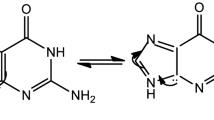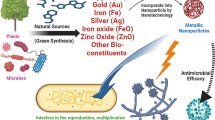Abstract—In this work, we have reported the synthesis of macrocyclic ligand and its nanostructured mononuclear Mn(II) and Cu(II) complexes using the sonication method. The spectral and elemental analyses have been done using UV–Vis spectroscopy, Fourier transform infrared (FT-IR) Spectroscopy, mass spectrometry, and carbon, hydrogen, and nitrogen elemental (CHN) analyses. The average size and surface morphological analysis of the synthesized nanocomplexes was evaluated using powder X-ray diffraction (XRD) and the field emission scanning electron microscopy (FE-SEM), respectively. The roughness of the nanostructured complexes was generalized by various statistical factors based on fractal studies. The results of the optical absorption data showed that the complexes have direct and indirect energy gap bands in the photon energy range from 2.33–4.31 eV. The various dispersion parameters like the refractive index, absorption index, dielectric constant, and optical conductivity were calculated and interpreted for the nanostructured complexes. The analysis of photoluminescent (PL) spectra showed that with the excitation wavelength of 260 and 460 nm, a strong band at 521 and 542 nm for Mn(II) and Cu(II), respectively, was observed in the emission spectrum. The obtained results indicate that the complexes can act as a promising candidate as green emitting light materials in electroluminescent and optoelectronic devices. The synthesized nanocomplexes were screened in vitro against fungal strains (Candida albicans and Aspergillus niger) and gram-positive bacterial strains (Listeria, Enterococcus faecalis, Bacillus subtilis and Staphylococcus aureus and gram-negative bacteria strains (Escherichia coli, Salmonella enterica, Acinetobacter calcoaceticus, Serratia marcescens) by the two-fold serial dilution method. The fractal and antimicrobial studies showed that Cu(II) complex is an excellent candidate to act as an antimicrobial agent.











Similar content being viewed by others
REFERENCES
Jiang, P., and Guo Z., Coord. Chem. Rev., 2004, vol. 248, p. 205.
Dutta, B., Bag, P., Flörke., and Nag, K., Inorg. Chem., 2005, vol. 44, p. 147.
Farag, A.A.M., and Yahia, I.S., Synth. Met., 2011, vol. 161, p. 32.
Zeyada, H.M., El-Nahass, M.M., El-Zawawi, I.K., and El-Menyawy, E.M. J. Phys. Chem. Solids., 2010, vol. 71, p. 867.
Patyal, M., Kaur, K., Gupta, N., Malik, A.K., and Paul, K., Asian J. Chem., 2022, vol. 34, p. 2424.
http://gwyddion.net. Accessed July 11, 2020.
Risovic, D., Pavlovic, Z., Scanning, 2013, vol. 35, p. 402.
Liu, H.B., Gao, W.W., Tangadanchu, V.K.R., Zhou, C.H., and Geng, R.X., Euro. J Medi. Chem., 2018, vol.143, p. 66.
Wayne, P.A., Reference method for broth dilution antifungal susceptibility testing of yeasts, approved standard 2002 CLSI document M27-A2.
K. Nakamoto, Handbook of Vibrational Spectroscopy, 2006.
El-Boraey, H.A., El-Salamony, M.A., and Hathout, A.A., J. Inc. Phenom. Macro. Chem., 2016, vol. 86, p. 153.
Kavitha, P., Saritha, M., and Reddy, K.L., Spectrochim. Acta A., 2013, vol. 102, p. 159.
Mahmoud, W.H., Deghadi, R.G., and Mohamed, G.G., App. Org. Chem., 2016, vol. 30, p. 221.
Sheikh, R.A., Wani, M.Y., Shreaz, S., and Hashmi, A.A., Arab. J. Chem., 2016, vol. 9, p. 743.
Fahem, A., Spectrochim Acta A., 2012, vol. 88, p.10.
Ibrahim, O.B., Mahmoud, A.M., Moamen, S.R., Can. Chem. Trans.,2014, vol. 2, p. 108.
Singh, A., Kumar, D., Thakur, A., Gupta, N., Shinde, V., Saini, B.S., and Kaur, R., Ionics., 2021, vol. 27, p. 2193.
Duan, Q., An, j., Mao, H., Liang, D., Li, H., Wang,S., and Huang, C., Materials., 2021, vol. 14, p. 860.
Ibrahim, A., Abdel-Aziz, M.H., Zoromba, M.S., and Al-Hossainy, A.F., Syn Met., 2018, vol. 238, p. 1.
Al-Hossainy, A.F., and Ibrahim, A., Opt. Mat., 2015, vol. 46, p. 131.
El-Gammal., O.A., El-Brashy, S.A., and Abu El-Reash, G.M., App. Org. Chem., 2020, vol. 34, p. 5456.
Paredes-García, V., Venegas-Yazigi, D., Cabrera, A., Valencia-Gálvez, P., Arriagada, M., Ruiz-Leon, D., and Spodine, E., Polyhedron.,2009, vol. 28, p. 2335.
Gaber, M., El-Wakiel, N., El-Baradie, K., Hafez, S., J. of the Iran. Chemi. Soc., 2019, vol. 16, p. 169.
More, G., Raut, D., Aruna, K., and Bootwala, S., J. Saudi. Chem. Soc.,2017, vol. 21, p. 954.
ACKNOWLEDGMENTS
We are grateful to CSIR, New Delhi, for financial help in the form of a junior research fellowship (file: 09/140(0180)/2020-EMR-I).
Author information
Authors and Affiliations
Corresponding author
Ethics declarations
The authors declare that they have no conflicts of interest.
Rights and permissions
About this article
Cite this article
Patyal, M., Kaur, K., Gupta, N. et al. Optical and Antimicrobial Activity of Nanostructured Mn(II) and Cu(II) Macrocyclic Complexes Derived from Aspartic Acid. Prot Met Phys Chem Surf 59, 169–178 (2023). https://doi.org/10.1134/S207020512370034X
Received:
Revised:
Accepted:
Published:
Issue Date:
DOI: https://doi.org/10.1134/S207020512370034X




